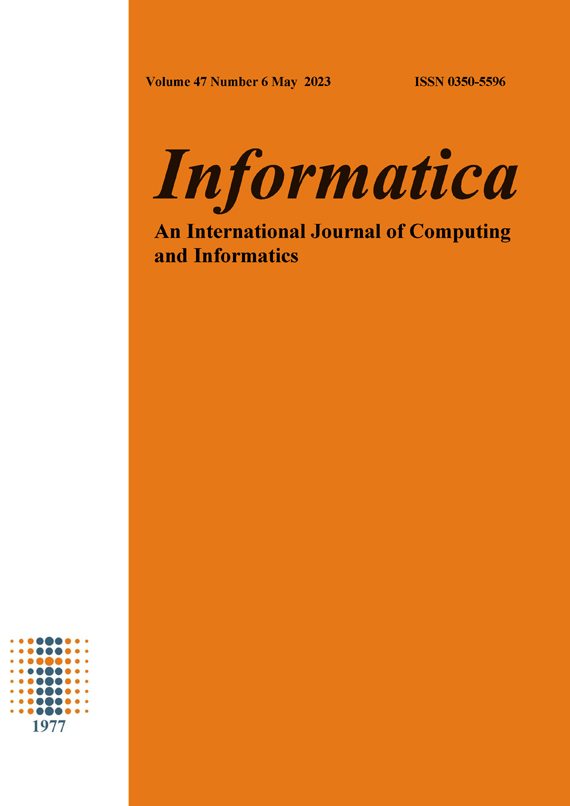Improved Model for Identifying the Cyberbullying based on Tweets of Twitter
DOI:
https://doi.org/10.31449/inf.v47i6.4534Abstract
The surge of cyberbullying on social media platforms is a major concern in today's digital age, with its prevalence escalating alongside advancements in technology. Thus, devising methods to detect and eliminate cyberbullying has become a crucial task. This research meticulously presents a refined model for identifying instances of cyberbullying, building on previous methodologies. The process of devising the model involved a thorough literature review, object-oriented design, and decision tree methodologies to shape the labelling procedure and build the classifier. Data pre-processing was executed using RapidMiner, considering six intrinsic components. The final model successfully classified Indonesian-language tweets into five distinct categories: animal, psychology and stupidity, disabled person, attitude, and general bullying, with an accuracy rate of 99.56%.
References
Kemp, Simon (Nov. 2021). Digital in Indonesia: All the statistics you need in 2021 - DataReportal – global digital insights. URL: https://datareportal.com/ reports/digital-2021-indonesia.
Siddiqui, Shabnoor, Tajinder Singh, et al. (2016). “Social media its impact with positive and negative aspects”. In: International journal of computer applications technology and research 5.2, pp. 71–75.
Setiawati, Denok and Muhammad Shiddiq Al Fathoni (2020). “Relational Bullying in Re- ligious School at the Senior High School Level”. In: International Joint Conference on Arts and Humanities (IJCAH 2020). Atlantis Press, pp. 170–173.
Samora, Julie Balch et al. (2020). “Harassment, discrimination, and bullying in or- thopaedics: a work environment and culture survey”. In: JAAOS-Journal of the American Academy of Orthopaedic Surgeons 28.24, e1097–e1104.
Febriany, Ade and Ditdit Nugeraha Utama (2021). “Analysis model for identifying negative posts based on social media”. In: International Journal of Emerging Technology and Advanced Engineering 11.10, pp. 104–108. DOI: 10.46338/ijetae1021_12.
Mat, Tiliza Awang, Adidah Lajis, and Haidawati Nasir (2018). “Text Data Preparation in RapidMiner for Short Free Text Answer in Assisted Assessment”. In: 2018 IEEE 5th International Conference on Smart Instrumentation, Measurement and Application (ICSIMA). IEEE, pp. 1–4.
Vyas, Vishal and V. Uma (2018). “An Extensive study of Sentiment Analysis tools and Binary Classification of tweets using Rapid Miner”. In: Procedia Computer Science 125. The 6th International Conference on Smart Computing and Communications, pp. 329– 335. ISSN: 1877-0509. DOI: https://doi.org/10.1016/j.procs.2017. 12.044. URL: https://www.sciencedirect.com/science/article/ pii/S1877050917328089.
Chen, Caixia, Liwei Geng, and Sheng Zhou (2021). “Design and implementation of bank CRM system based on decision tree algorithm”. In: Neural Computing and Applications 33.14, pp. 8237–8247.
Aldino, Ahmad Ari and Heni Sulistiani (2020). “Decision Tree C4. 5 Algorithm For Tuition Aid Grant Program Classification (Case Study: Department Of Information System, Universitas Teknokrat Indonesia)”. In: Edutic-Scientific Journal of Informatics Educa- tion 7.1.
Shimomoto, Erica K. et al. (2018). “Text Classification Based On Word Subspace With Term-Frequency”. In: 2018 International Joint Conference on Neural Networks (IJCNN), pp. 1–8. DOI: 10.1109/IJCNN.2018.8489458.
Jiang, Haiyun et al. (2020). “Understanding a bag of words by conceptual labeling with prior weights”. In: World Wide Web 23.4, pp. 2429–2447.
Haidar, Batoul, Maroun Chamoun, and Ahmed Serhrouchni (2017). “Multilingual cyberbullying detection system: Detecting cyberbullying in Arabic content”. In: 2017 1st Cyber Security in Networking Conference (CSNet). IEEE, pp. 1–8.
Isa, Sani Muhamad, Livia Ashianti, et al. (2017). “Cyberbullying classification using text mining”. In: 2017 1st International Conference on Informatics and Computational Sciences (ICICoS). IEEE, pp. 241–246.
Nurrahmi, Hani and Dade Nurjanah (2018). “Indonesian twitter cyberbullying detection using text classification and user credibility”. In: 2018 International Conference on Information and Communications Technology (ICOIACT). IEEE, pp. 543–548.
Dharmarajan, K et al. (2020). “Thyroid disease classification using decision tree and SVM”. In: Indian Journal of Public Health Research & Development 11.3, pp. 229–233.
Ghasemi, Ebrahim, Hasan Gholizadeh, and Amoussou Coffi Adoko (2020). “Evaluation of rockburst occurrence and intensity in underground structures using decision tree approach”. In: Engineering with Computers 36.1, pp. 213–225.
Marie-Sainte, Souad Larabi et al. (2018). “Arabic natural language processing and machine learning-based systems”. In: IEEE Access 7, pp. 7011–7020.
Downloads
Published
Issue
Section
License
I assign to Informatica, An International Journal of Computing and Informatics ("Journal") the copyright in the manuscript identified above and any additional material (figures, tables, illustrations, software or other information intended for publication) submitted as part of or as a supplement to the manuscript ("Paper") in all forms and media throughout the world, in all languages, for the full term of copyright, effective when and if the article is accepted for publication. This transfer includes the right to reproduce and/or to distribute the Paper to other journals or digital libraries in electronic and online forms and systems.
I understand that I retain the rights to use the pre-prints, off-prints, accepted manuscript and published journal Paper for personal use, scholarly purposes and internal institutional use.
In certain cases, I can ask for retaining the publishing rights of the Paper. The Journal can permit or deny the request for publishing rights, to which I fully agree.
I declare that the submitted Paper is original, has been written by the stated authors and has not been published elsewhere nor is currently being considered for publication by any other journal and will not be submitted for such review while under review by this Journal. The Paper contains no material that violates proprietary rights of any other person or entity. I have obtained written permission from copyright owners for any excerpts from copyrighted works that are included and have credited the sources in my article. I have informed the co-author(s) of the terms of this publishing agreement.
Copyright © Slovenian Society Informatika








